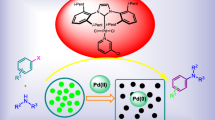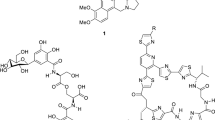Abstract
We report the solid phase synthesis of –GG-X-GG– type α/β-carbopeptoids incorporating RibAFU(ip) (1a, tX) or XylAFU(ip) (2a, cX) sugar amino acids. Though coupling efficacy is moderate, both the lengthier synthetic route using Fmoc derivative (e.g., Fmoc-RibAFU(ip)-OH) and the azido derivative (e.g., N3-RibAFU(ip)-OH) via Staudinger reaction with nBu3P can be successfully applied. Both X-ray diffraction, 1H- and 31P-NMR, and theoretical (QM) data support and explain why the application of Ph3P as Staudinger reagent is “ineffective” in the case of a cis stereoisomer, if cX is attached to the preceding residue with a peptide (–CONH–) bond. The failure of the polypeptide chain elongation with N3-cX originates from the “coincidence” of a steric crowdedness and an electronic effect disabling the mandatory nucleophilic attack during the hydrolysis of a quasi penta-coordinated triphenylphosphinimine. Nevertheless, the synthesis of the above α/β-chimera peptides as completed now by a new pathway via 1,2-O-isopropylidene-3-azido-3-deoxy-ribo- and -xylo-furanuronic acid (H-RibAFU(ip)-OH 1a and H-XylAFU(ip)-OH 2a) coupled with N-protected α-amino acids on solid phase could serve as useful examples and starting points of further synthetic efforts.









Similar content being viewed by others
Abbreviations
- H-RibAFU(ip)-OH or tX:
-
1,2-O-Isopropylidene-3-amino-3-deoxy-α-d-ribofuranuronic acid
- H-XylAFU(ip)-OH or cX:
-
1,2-O-Isopropylidene-3-amino-3-deoxy-α-d-xylofuranuronic acid
- N3-RibAFU(ip)-OH:
-
1,2-O-Isopropylidene-3-azido-3-deoxy-α-d-ribofuranuronic acid
- N3-XylAFU(ip)-OH:
-
1,2-O-isopropylidene-3-azido-3-deoxy-α-d-xylofuranuronic acid
- H-RibAFU(ip)-NHMe:
-
N-Methyl-1,2-O-isopropylidene-3-amino-3-deoxy-α-d-ribofuranuronamide
- H-XylAFU(ip)-NHMe:
-
N-methyl-1,2-O-isopropylidene-3-amino-3-deoxy-α-D-xylofuranuronamide
- H-XylAFU(ip)-NHMe2 :
-
N,N-Dimethyl-1,2-O-isopropylidene-3-amino-3-deoxy-α-d-xylofuranuronamide
References
Andreini M, Taillefumier C, Chretien F, Thery V, Chapleur Y (2009) Synthesis and solution conformation of homo-β-peptides consisting of N-mannofuranosyl-3-ulosonic acids. J Org Chem 74:7651–7659
Barlos K, Chatzi O, Gatos D, Stavropoulos G (1991) 2-Chlorotrityl chloride resin—studies on anchoring of Fmoc-amino acids and peptide cleavage. Int. J. Peptide Protein Res 37:513–520
Beck DAC, Alonso DOV, Inoyama D, Daggett V (2008) The intrinsic conformational propensities of the 20 naturally occurring amino acids and reflection of these propensities in proteins. PNAS 105:12259–12264
Beke T, Csizmadia IG, Perczel A (2004) On the flexibility of β-peptides. J Comput Chem 25:285–307
Beke T, Czajlik A, Bálint B, Perczel A (2008) A theoretical comparison of self-assembling α- and β-peptide nanostructures: toward design of β-barrel frameworks. ACS Nano 2:545–553
Brase S, Gil C, Knepper K, Zimmermann V (2005) Organic azides: an exploding diversity of a unique class of compounds. Angew Chem Int Ed 44:5188–5240
Cabrele C, Martinek TA, Reiser O, Berlicki Ł (2014) Peptides containing β-amino acid patterns: challenges and successes in medicinal chemistry. J Med Chem 57:9718–97393
Chan WC, White PD (2000) Fmoc solid phase peptide synthesis—a practical approach. Oxford University Press, Oxford
Chandrasekhar S, Reddy SM, Jagadeesh B, Prabhakar A, Ramana Rao MHV, Jagannadh B (2004) Formation of a stable 14-helix in short oligomers of furanoid cis-β-sugar-amino acid. J Am Chem Soc 126:13586–13587
Chandrasekhar S, Rao CL, Seenaiah M, Naresh P, Jagadeesh B, Manjeera D, Sarkar A, Bhadra MP (2009) Total synthesis of azumamide E and sugar amino acid-containing analogue. J Org Chem 74:401–404
Cheng RP, Gellman SH, DeGrado WF (2001) Beta-peptides: from structure to function. Chem Rev 101:3210–3232
Frisch MJ et al (2009) Gaussian 09, Revision B.01. Gaussian, Inc., Wallingford CT
García-Martín F, Bayó-Puxan N, Cruz LJ, Bohling JC, Albericio F (2007) Chlorotrityl chloride (CTC) resin as a reusable carboxyl protecting group. QSAR Comb Sci 26:1027–1035
Giri AG, Jogdand GF, Rajamohanan PR, Pandey SK, Ramana CV (2012) Synthesis and structural characterization of homochiral homo-oligomers of cis-γ-methoxy-substituted cis- and trans-furanoid-β-amino acids. Eur. J. Org. Chem. 2012:2656–2663
Glendening ED, Badenhoop JK, Reed AE, Carpenter JE, Bohmann JA, Morales CM, Weinhold F (2001) NBO v. 5.9. 5.9 ed. Theoretical Chemistry Institute, University of Wisconsin, Madison, Wisconsin
Gololobov YG (1992) Recent advances in the Staudinger reaction. Tetrahedron 48:1353–1406
Gololobov YG, Zhmurova LN, Kasukhin LF (1981) Sixty years of Staudinger reaction. Tetrahedron 37:437–472
Gruner SAW, Gy Kéri, Venetainer A, Kessler H (2001) Sugar amino acid containing somatostatin analogues that induce apoptosis in both drug-sensitive and multidrug-resistant tumor cells. Org Lett 3:3723–3725
Gruner SAW, Locardi E, Lohof E, Kessler H (2002a) Carbohydrate-based mimetics in drug design: sugar amino acids and carbohydrate scaffolds. Chem Rev 102:491–514
Gruner SAW, Truffault V, Voll G, Locardi E, Stöckle M, Kessler H (2002b) Design, synthesis, and NMR structure of linear and cyclic oligomers containing novel furanoid sugar amino acids. Chem Eur J 8:4365–4376
Guichard G, Huc I (2011) Synthetic foldamers. Chem Commun 47:5933–5941
Hecht S, Huc I (2007) Foldamers: structure, properties and applications. Wiley-VCH, Weinheim
Herradón B, Seebach D (1989) Mono- and dialkylation of derivatives of (1R,2S)-2-hydroxycyclopentanecarboxylic acid and -cyclohexanecarboxylic acid via bicyclic dioxanones: selective generation of three contiguous stereogenic centers on a cyclohexane ring. Helv Chim Acta 72:690–714
Horne WS, Gellman SH (2008) Foldamers with heterogeneous backbones. Acc Chem Res 41:1399–1408
John F, Wittmann V (2015) Orthogonally protected furanoid sugar diamino acids for solid-phase synthesis of oligosaccharide mimetics. J Org Chem 80:7477–7485
Kessler H, Diefenbach B, Finsinger D, Geyer A, Gurrath M, Goodman SL, Hölzemann G, Haubner R, Jonczyk A, Müller G, Graf von Roedern E, Wermuth J (1995) Design of superactive and selective integrin receptor antagonists containing the RGD sequence. Lett Pept Sci 2:155–160
Kocsis L, Ruff F, Gy Orosz (2006) The effect of peptide length on the cleavage kinetics of 2-chlorotrityl resin-bound ethers. J Pept Sci 12:428–436
Kovács J, Pintér I, Messmer A, Tóth G (1985) Unprotected sugar phosphinimines: a facile route to cyclic carbamates of aminosugars. Carbohydr Res 141:57–65
Leffler JE, Temple RD (1967) Staudinger reaction between triarylphosphines and azides. A study of the mechanism. J Am Chem Soc 89:5235–5246
Long DD, Hungerford NL, Smith MD, Brittain DEA, Marquess DG, Claridge TDW, Fleet GWJ (1999) From sequencamers to foldamers? Tetrameric furanose carbopeptoids from cis- and trans-5-aminomethyl-tetrahydrofuran-2-carboxylates. Tetrahedron Lett 40:2195–2198
Lundquist JT, Pelletier JC (2001) Improved solid-phase peptide synthesis method utilizing α-azide-protected amino acids. Org Lett 3:781–783
Malkinson JP, Falconer RA, Tóth I (2000) Synthesis of C-terminal glycopeptides from resin-bound glycosyl azides via a modified staudinger reaction. J Org Chem 65:5249–5252
Mándity IM, Fülöp F (2015) An overview of peptide and peptoid foldamers in medicinal chemistry. Exp Opin Drug Discov 10:1163–1177
Martinek TA, Fülöp F (2012) Peptidic foldamers: ramping up diversity. Chem Soc Rev 41:687–702
Meldal M, Juliano MA, Jansson AM (1997) Azido acids in a novel method of solid-phase peptide synthesis. Tetrahedron Lett 38:2531–2534
Messmer A, Pintér I, Szegő F (1964) Triphenylphosphine N-acetylglycosylimides and N, N′-bis(acetylglycosyl)carbodiimides. Angew Chem Int Ed 3:228
Nilsson BL, Kiessling LL, Raines RT (2000) Staudinger ligation: a peptide from a thioester and azide. Org Lett 2:1939–1941
Pandey SK, Jogdand GF, Oliveira JCA, Mata RA, Rajamohanan PR, Ramana CV (2011) Synthesis and structural characterization of homochiral homo-oligomers of parent cis- and trans-furanoid-β-amino acids. Chem Eur J 17:12946–12954
Pilsl LKA, Reiser O (2011) α/β-Peptide foldamers: state of the art. Amino Acids 41:709–718
Risseeuw MDP, Overhand M, Fleet GWJ, Simone MI (2013) A compendium of cyclic sugar amino acids and their carbocyclic and heterocyclic nitrogen analogues. Amino Acids 45:613–689
Saxon E, Armstrong JI, Bertozzi CR (2000) A “traceless” staudinger ligation for the chemoselective synthesis of amide bonds. Org Lett 2:2141–2143
Schilling CI, Jung N, Biskup M, Schepers U, Bräse S (2011) Bioconjugation via azide–Staudinger ligation: an overview. Chem Soc Rev 40:4840–4871
Sharma GVM, Nagendar P, Ramakrishna KVS, Chandramouli N, Choudhary M, Kunwar AC (2008) Three-residue turns in α/β-peptides and their application in the design of tertiary structures. Chem Asian J 3:969–983
Sharma GVM, Reddy PS, Chatterjee D, Kunwar AC (2011) Synthesis and structural studies of homooligomers of geminally disubstituted β2,2-amino acids with carbohydrate side chain. J Org Chem 76:1562–1571
Shi Z, Chen K, Liu Z, Ng A, Bracken WC, Kallenbach NR (2005) Polyproline II propensities from GGXGG peptides reveal an anticorrelation with β-sheet scales. Proc Natl Acad Sci USA 102:17964–17968
Simone MI, Soengas R, Newton CR, Watkin DJ, Fleet GWJ (2005) Branched tetrahydrofuran α,α-disubstituted-δ-sugar amino acid scaffolds from branched sugar lactones: a new family of foldamers? Tetrahedron Lett 46:5761–5765
Staudinger H, Hauser E (1921) Über neue organische phosphorverbindungen IV phosphinimine Helv. Chim. Acta 4:861–886
Staudinger H, Meyer J (1919) Über neue organische phosphorverbindungen III. Phosphinmethylenderivate und phosphinimine. Helv Chim Acta 2:635–646
Temelkoff DP, Zeller M, Norris P (2006) N-Glycoside neoglycotrimers from 2,3,4,6-tetra-O-acetyl-β-d-glucopyranosyl azide. Carbohydr Res 341:1081–1090
Tornøe CW, Davis P, Porreca F, Meldal M (2000) α-Azido acids for direct use in solid-phase peptide synthesis. J Pept Sci 6:594–602
Van Rompaey P, Jacobson KA, Gross AS, Gao ZG, Van Calenbergh S (2005) Exploring human adenosine A3 receptor complementarity and activity for adenosine analogues modified in the ribose and purine moiety. Biorg Med Chem 13:973–983
Acknowledgments
The authors wish to thank László Kocsis and Gábor Szirbik from ThalesNano Inc. (Budapest, Hungary) for their help and advice in the hydrogenation reaction. The Biostruct Laboratory at the Budapest University of Technology and Economics is acknowledged for collecting X-ray diffraction data. The authors thank Petra Rovó for her help in NMR measurements. This work was supported by grants from the Hungarian Scientific Research Fund (OTKA K72973, NK101072) and TÁMOP-4.2.1. B-09/1/KMR.
Author information
Authors and Affiliations
Corresponding author
Ethics declarations
Conflict of interest
The authors declare that they have no conflict of interest.
Research involving human participants and/or animals
This article does not contain any studies with human participants or animals performed by any of the authors.
Additional information
Handling Editor: J. Bode.
Electronic supplementary material
Below is the link to the electronic supplementary material.
Rights and permissions
About this article
Cite this article
Csordás, B., Nagy, A., Harmat, V. et al. Origin of problems related to Staudinger reduction in carbopeptoid syntheses. Amino Acids 48, 2619–2633 (2016). https://doi.org/10.1007/s00726-016-2289-x
Received:
Accepted:
Published:
Issue Date:
DOI: https://doi.org/10.1007/s00726-016-2289-x




